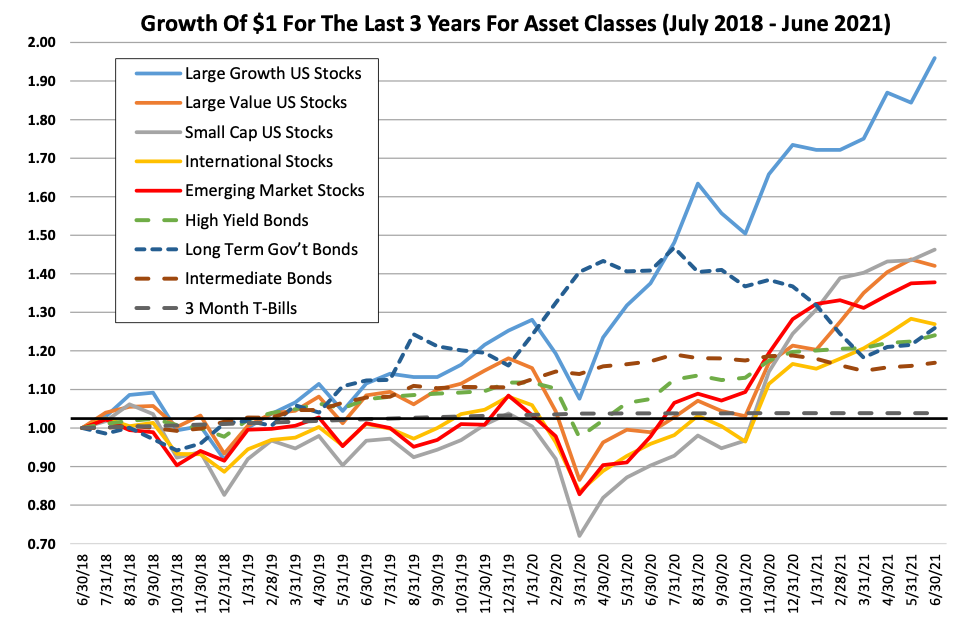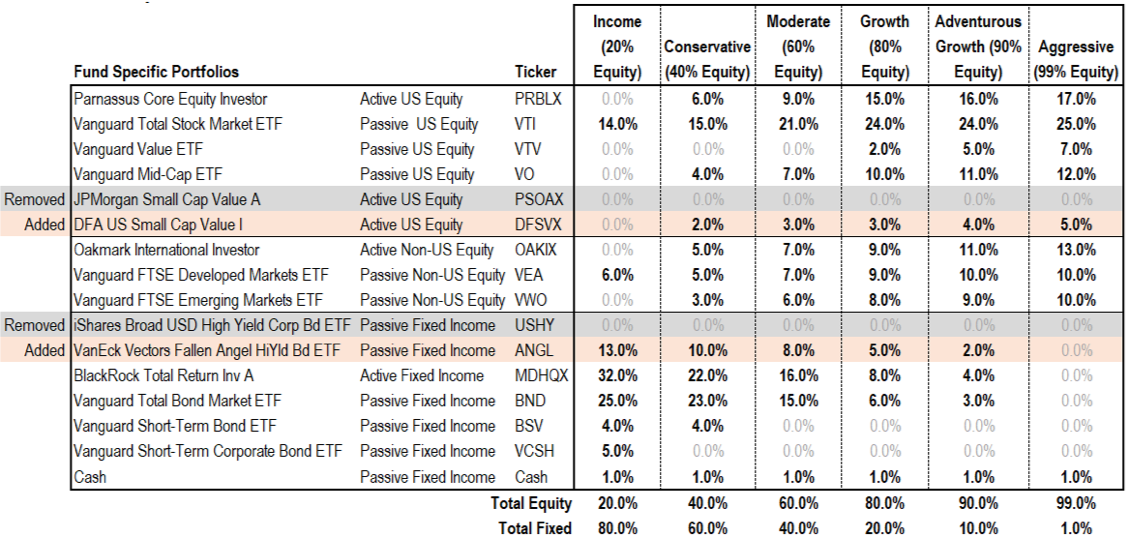Asset Class Recap as of 6/30/2021
The second quarter was terrific for investors, as every asset class and fund we include in our portfolios produced positive returns. The U.S. government’s progress toward passing a plan to massively increase federal spending has been perceived by investors as a positive for future stock earnings, pushing stock prices up accordingly. Large Growth stocks led the charge last quarter as the largest U.S. growth oriented corporations including Microsoft, Amazon, Facebook and Apple saw their stock prices increase more than 10% this last quarter.
| Asset Class/ Category Returns As Of 6/30/2021 |
Annualized Return |
Annualized Return |
Representative Benchmark or Index Name | |||
|---|---|---|---|---|---|---|
| Large Growth US Stocks | Russell 1000 Growth | |||||
| Large Value US Stocks | Russell 1000 Value | |||||
| Small Cap US Stocks | Russell 2000 | |||||
| International Stocks | MSCI EAFE | |||||
| Emerging Market Stocks | MSCI Emerging Markets | |||||
| High Yield Bonds | BBgBarc US Corporate High Yield | |||||
| Long Term Gov’t Bonds | BBgBarc Long Term US Treasury | |||||
| Intermediate Bonds | BBgBarc US Agg Bond | |||||
| 3 Month T-Bills | BBgBarc US Treasury Bill 1-3 Mon | |||||
| Target Date 2035 Cat Avg | US Fund Target-Date 2035 | |||||
| 70-85% Equity Alloc Cat | US Fund Alloc 70% to 85% Equity |
Source: Morningstar Data on 7/7/21
The chart below shows three year growth over time for these same asset classes, presented as the hypothetical growth of $1 in each asset class. It is easy to pick out the COVID related market pull back between 12/31/19 and 3/31/20 and it is equally clear that broad markets have done quite well when viewed over the longer term. Large Growth’s run is starting to stand out on this chart like a classic bubble, as this asset class has been on a tear for the last five quarters. Many market timers who strongly underweighted Growth after its first couple quarters of outperformance have missed out on a lot of momentum based return. Although long term oriented investors like us may wring their hands in worry about high valuations, we do not try to time markets month to month and put our savings at risk by focusing our investments into narrow market segments. That said, our return expectations for Growth have dropped meaningfully, as Growth has earned 23.7% (geometric annualized) over the last five years. We have already been carrying a slight Value tilt in our more aggressive portfolios and I increased our Value target by 2% in our three most aggressive portfolios using Vanguard Value ETF (ticker: VTV).

Data as of 7/13/2021. See the appendix for details and disclosures.
Two Fund Replacements - One Active Mutual Fund and One ETF
We have not made changes to the funds we use in our portfolios since they were officially rolled out at 7/31/2020. There are two funds that I have been following for many years that we are adding to our model portfolios. These funds will be added to client portfolios at each client’s next update, taking each account’s tax status into consideration - tax deferred accounts can trade freely without tax ramifications, but taxable accounts will be reviewed carefully before fund replacement trades are done.
DFA Small Cap Equity (ticker: DFSVX) -
This was one of the first fund strategies that I worked with when I started at Northern Trust in 1994. One of my large corporate clients in Portland included this fund in their pension and it left an impression on me for a few reasons. The strategy purchases a large number of very small companies that were difficult to value because some of them did not trade often. This made it difficult to produce accurate accounting reports (my first investments related job). But when we did catch up and collect fresh stock prices and it came time to calculate fund performance, many times this fund’s return was so high that I initially thought it was an error, but it wasn’t. This fund has been around since 1993 and has performed very well. Its outsized returns come with significant volatility though. This fund can go through long periods of underperformance, including consecutive negative years, and it has one of the highest standard deviations for a mutual fund in Morningstar’s database. That is one reason our allocations are below 6% in our aggressive portfolios, with lower allocations in the more conservative portfolios.
There is a lot of academic research on small-cap and value outperformance, with many theories about the sources of outperformance, and Dimensional Fund Advisors (DFA) was founded by academics with the goal of incorporating many of these theories. DFA requires advisors to go through a vetting process before they allow the advisor to sell their funds, which I wrapped up last month. This website has more information on the fund https://us.dimensional.com/funds/us-small-cap-value This fund will replace JP Morgan Small Cap Value in our portfolios.
VanEck Vectors Fallen Angel High Yield Bond ETF (ticker: ANGL) -
We currently use iShares Broad USD High Yield Corporate Bond ETF (ticker: USHY) in our portfolios to get high yield exposure. USHY is a traditional, diverse, index-based product that holds 2,125 individual bonds that are rated below investment grade. I believe USHY is a fine product, but I have also been following ANGL since it rolled out in 2012. ANGL follows a unique high yield index nicknamed a “fallen angel” strategy. This strategy buys bonds that were recently high quality (investment grade) whose parent companies have recently run into financial difficulty that has caused ratings agencies to move their bond quality ratings down to low quality (non-investment grade). Research has shown that the market often overreacts and pushes prices for these bonds down too far, offering a bargain for investors who are willing to “bottom feed”.
There are two ETF’s for sale in the U.S. that incorporate a fallen angel strategy; ANGL from VanEck and FALN from iShares. After doing a lot of research on both ETF’s, I believe ANGL may be a slightly more attractive option for our portfolios. If you would like me to send you my research document that compares ANGL to FALN, send me an email and I will send it to you. This site has detailed information for ANGL. https://www.vaneck.com/us/en/investments/angel-high-yield-bond-etf-angl/
These are our updated model portfolio target allocations after the two fund changes.

Disclosures
Opinions expressed are as of the current date; such opinions are subject to change without notice. Advyzon Investment Management shall not be responsible for any trading decisions, damages, or other losses resulting from, or related to, the information, data, analyses or opinions or their use. This commentary is for informational purposes only. The information, data, analyses, and opinions presented herein do not constitute investment advice, are provided solely for informational purposes and therefore are not an offer to buy or sell a security. Please note that references to specific securities or other investment options within this piece should not be considered an offer (as defined by the Securities and Exchange Act) to purchase or sell that specific investment.
Performance data shown represents past performance. Past performance does not guarantee future results. All investments involve risk, including the loss of principal. There can be no assurance that any financial strategy will be successful. This commentary contains certain forward-looking statements. We may use words such as “expects”, “anticipates”, “believes”, “estimates”, “forecasts”, and similar expressions to identify forward-looking statements. Such forward-looking statements involve known and unknown risks, uncertainties and other factors which may cause the actual results to differ materially and/or substantially from any future results, performance or achievements expressed or implied by those projected in the forward-looking statements for any reason.
Investment management and financial advice offered by Advyzon Investment Management is intended for citizens or legal residents of the United States or its territories. Investing in securities involves risks, including but are not limited to; currency risk, political risk, geographic risk, concentration risk, custody risk, asset class risk, management risk, market risk, operational risk, passive investment risk, securities lending risk, tracking error risk, tax risk, valuation risk, and infectious illness risk. Investing in emerging markets may increase these risks. Emerging markets are countries with relatively young stock and bond markets. Typically, emerging-markets investments have the potential for losses and gains larger than those of developed-market investments. A debt security refers to money borrowed that must be repaid that has a fixed amount, a maturity date(s), and usually a specific rate of interest. Some debt securities are discounted in the original purchase price. Examples of debt securities are treasury bills, bonds and commercial paper. The borrower pays interest for the use of the money and pays the principal amount on a specified date. High yield debt (non-investment grade or junk bonds) can be more risky than higher rated debt, typically has a higher default rate than investment grade and treasury debt, and high yield funds can lose principal.
The indexes noted are unmanaged and cannot be directly invested in. Individual index performance is provided as a reference only. Since indexes and/or composition levels may change over time, actual return and risk characteristics may be higher or lower than those presented. Although index performance data is gathered from reliable sources, Advyzon Investment Management cannot guarantee its accuracy, completeness or reliability.
Cryptocurrencies, including Bitcoin, are currently unregulated, illiquid, uninsured, carry technological risks, require unique tax treatment, and are volatile.


